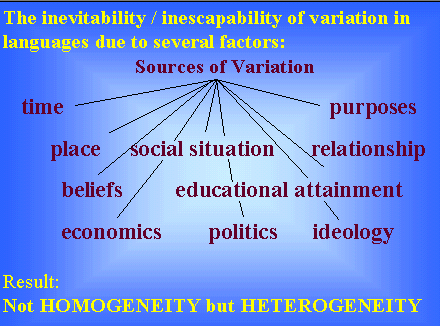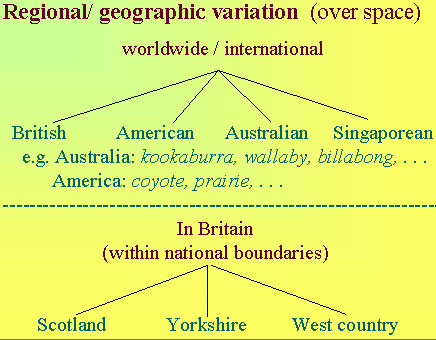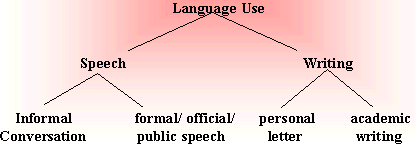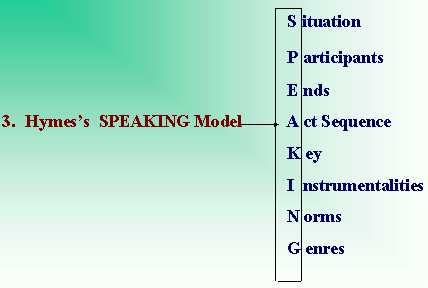
EL1102 Lecture 7 (Part 1)
Social variation: register, genre and competence



Some very general examples:

| Speech | Writing |
| Hey, how about dinner? | We would very much like you to join us for dinner tonight. |
| Nothing doing! No way! I can’t let you have this. | I regret to inform you that I will not be able to accede to your request. |
| Informal | Formal |
| A:
What a car! So shiok! Shall we buy that one?
B: No, lah. Where got so much money ? |
A:
The car is a real beauty. Would you care to check it out one of
these days?
B: I don't suppose we could afford to pay such a stupendous price for a car like that. |
The difference here reflects the amount of attention paid to language by the user, which depends on the context.
|
What
is being focused on
|
Where: Context of situation | |
| FIELD | The
topic (“what”)
and the purpose
(“why”) of
communication
|
If
Doctor – patient, medical
history,
ailments, hospitalisation. If Teacher-pupil,
in a science lesson/ Physics lecture |
| MODE | The means (“how”) of communication: whether spoken or written, face-to-face, one-way or two-way, etc. | If spoken, face-to-face or telephonic. If written, personalor official or newspaper / journalistic or academic, etc. |
| TENOR | The style (“to whom”) of communication – whether formal or informal, determined by the roles of the participants & their relationship with each other. |
Doctor
- patient
(F)
Teacher
– student (F)
Interviewer
– interviewee (F)
Mother
- child
(INF)
Friend
– friend (INF)
|
|
1. A tailor calling up to say his new suit is ready 2. A good friend for a number of years 3. His young grandchild 4. His drill sergeant in the army 5. His former elementary school teacher 6. A store-detective who thinks he’s a shoplifter 7. His former Hollywood agent |
Ron Mr Reagan Ronald Gramps Reagan Ronnie baby Hey, you |
2. Fishman’s Model
| DOMAINS | Certain
spheres of activity
Institutionalised
contexts/ Classes of “congruent” situations / major clusters of
interaction situations
|
home,
school, market /
shop,
religion, office, recreation, etc.
|
| ROLES | Sets
of mutual rights and obligations – determined
by
socio-cultural norms &
expectations
|
Parent-
child, sibling,
Teacher-student,
Buyer-seller, Employer-
employee |
| FUNCTIONS |
Diglossia
– functional
allocation
of use of two varieties of a language –
High
(H) and low (L).
|
To
inform, acquire,
buy,
sell, reassure,
etc.
|

| Situation |
Setting
Scene
|
Physical,
time and place
e.g.
LT 15, AS 6, NUS
Abstract,
psychological setting,
involves
cultural definition of
occasion.
e.g. EL 1102 Lecture
|
| Participants |
Speaker
/ Addressor
Hearer
/ Addressee,
Audience
|
Whom
the speech act
is addressed to, & who it is uttered by. Often
participants are allocated communication roles by
their culture – e.g. ‘doctor – patient’,
‘teacher
– student’, ‘interviewer-
Interviewee’,
‘therapist - client’.
|
| Ends |
Purposes
– outcomes
Purposes-
individual goals
|
Some
speech events have conventional outcomes, e.g. a
diagnosis’,
‘a sale’ or ‘a verdict’
|
| Act sequences |
Message
form
Message
content
|
HOW
it is said
WHAT
is said
|
| Key |
Tone,
manner or spirit in which the event is carried out
|
Informal, formal (style) perfunctory, relaxed, intense |
| Instrumentalities |
Channel
or mode of discourse
Forms
of speech
Spoken,
written, written but read aloud, recited, etc
|
The
dialect, accent or other
variety
of speech in which
the
act is uttered.
|
| Norms |
Ns
of interpretation
Ns
of interaction
Expected
interpretation.
|
Interpretation in relation to the conventions of conversation, turn-taking, etc |
| Genres | Text types or categories of texts |
Poems,
myths, stories,
sermons,
lectures, editorials,
etc.
|
The patterned nature of variation
15. a) Revolutionary new ideas appear infrequently.
16. Visiting relatives can be difficult.
17. Flying planes can be dangerous.
C. The ability to see relations (structural, semantic) among elements which are not overt
TWO kinds of Competence: linguistic competence and communicative competence
HUMILIATE a friend or allow the whole country to be humiliated.
He dismissed talk of a conspiracy to end the political career of his heir apparent, saying that the baton of power was about to be handed over then. Instead, it was Anwar who had a hidden agenda. He built a cult of personality while in government, the Prime Minister charged.
Some dealers expect the bourse to trade higher this week with improvements in earnings of listed companies and a better economic outlook.
On the other hand, the gush of positive news seemed to have been negated largely by developments outside Singapore.
GOLDLION
4. Vieri marks debut with hat-trick
5. Surprise Apple Cake
Academic Genres
- they are not ‘COMMONSENSE KNOWLEDGE” associated with
- they claim “objectivity”, but embody particular views of reality of the subject and its concerns, which are predetermined by the interests of the groups involved.
- the need for CRITICAL AWARENESS of how exactly they work BEYOND THE MERE DECODING of what “is there”. And to INTERROGATE what we read, DECONSTRUCT them, RESIST them where necessary, RECONSTRUCT them to express our own meanings